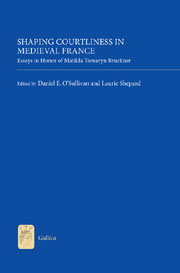Book contents
- Frontmatter
- Contents
- List of Illustrations
- Acknowledgements
- Introduction
- Matilda Tomaryn Bruckner: A Bibliography
- Part I Shaping Real and Fictive Courts
- Part II Shaping Courtly Narrative
- Part III Shaping Women's Voices in Medieval France
- Lombarda's Mirrors: Reflections on PC 288,1 as a Response 165 to PC 54,1
- Na Maria: Courtliness and Marian Devotion in Old Occitan Lyric
- From Convent to Court: Ermengarde d'Anjou's Decision to Reenter the World
- From Chrétien to Christine: Translating Twelfth-Century Literature to Reform the French Court during the Hundred Years War
- Part IV Shaping the Courtly Other
- Envoi
- List of Contributors
- Index
- Tabula Gratulatoria
- Already Published
From Convent to Court: Ermengarde d'Anjou's Decision to Reenter the World
from Part III - Shaping Women's Voices in Medieval France
Published online by Cambridge University Press: 05 May 2013
- Frontmatter
- Contents
- List of Illustrations
- Acknowledgements
- Introduction
- Matilda Tomaryn Bruckner: A Bibliography
- Part I Shaping Real and Fictive Courts
- Part II Shaping Courtly Narrative
- Part III Shaping Women's Voices in Medieval France
- Lombarda's Mirrors: Reflections on PC 288,1 as a Response 165 to PC 54,1
- Na Maria: Courtliness and Marian Devotion in Old Occitan Lyric
- From Convent to Court: Ermengarde d'Anjou's Decision to Reenter the World
- From Chrétien to Christine: Translating Twelfth-Century Literature to Reform the French Court during the Hundred Years War
- Part IV Shaping the Courtly Other
- Envoi
- List of Contributors
- Index
- Tabula Gratulatoria
- Already Published
Summary
At first glance, Ermengarde of Anjou, the countess of Brittany who died in 1146, does not seem especially suitable for a study of the role of women in the emergence of secular literature in the aristocratic court. She is not named as a patroness in any roman courtois, and only one extant lyric celebrates her beauty, not the work of a troubadour or trouvère, but a Latin poem written by Marbode, the bishop of Rennes. Nonetheless, in La femme au temps des cathédrales, Régine Pernoud uses Ermengarde as an example of how women could inspire an attitude of “courtliness,” of love and respect, in even the most austere men of the church. Furthermore, Pernoud explicitly connects this twelfth-century “courtliness” to the sixth-century poet Venantius Fortunatus, who expressed himself in similar terms in the Latin poems he addressed to the sainted Merovingian queen and nun Radegund.
Despite this common thread, the experiences of Ermengarde and Radegund were quite different, and these differences lead one to question the simple relationship between “courtliness” and respect for women proposed by Pernoud. Fortunatus and Marbode both extol the beauty and grace of their addressees, but their poems are firmly rooted in the culture of the church.
- Type
- Chapter
- Information
- Shaping Courtliness in Medieval FranceEssays in Honor of Matilda Tomaryn Bruckner, pp. 201 - 212Publisher: Boydell & BrewerPrint publication year: 2013



